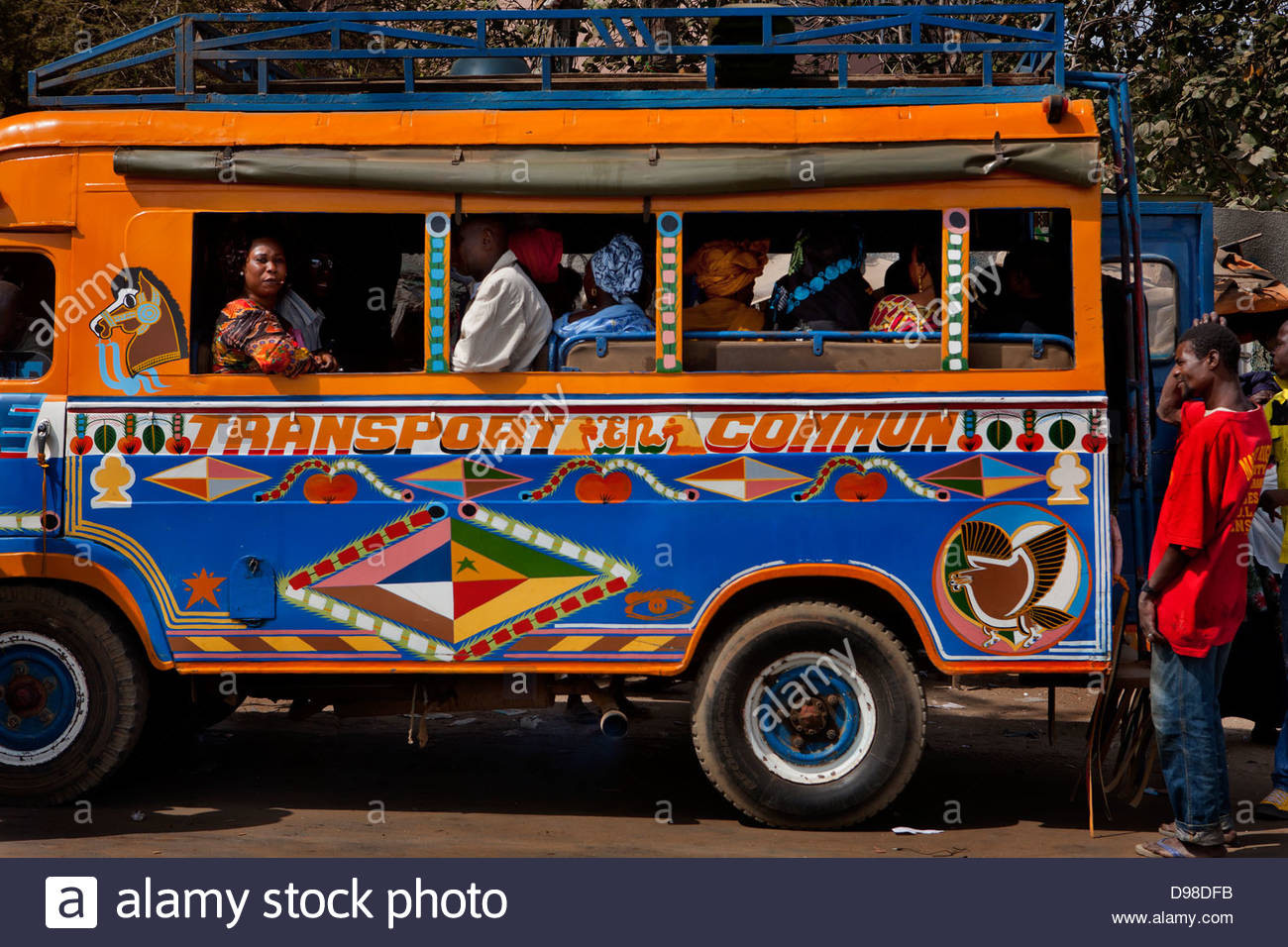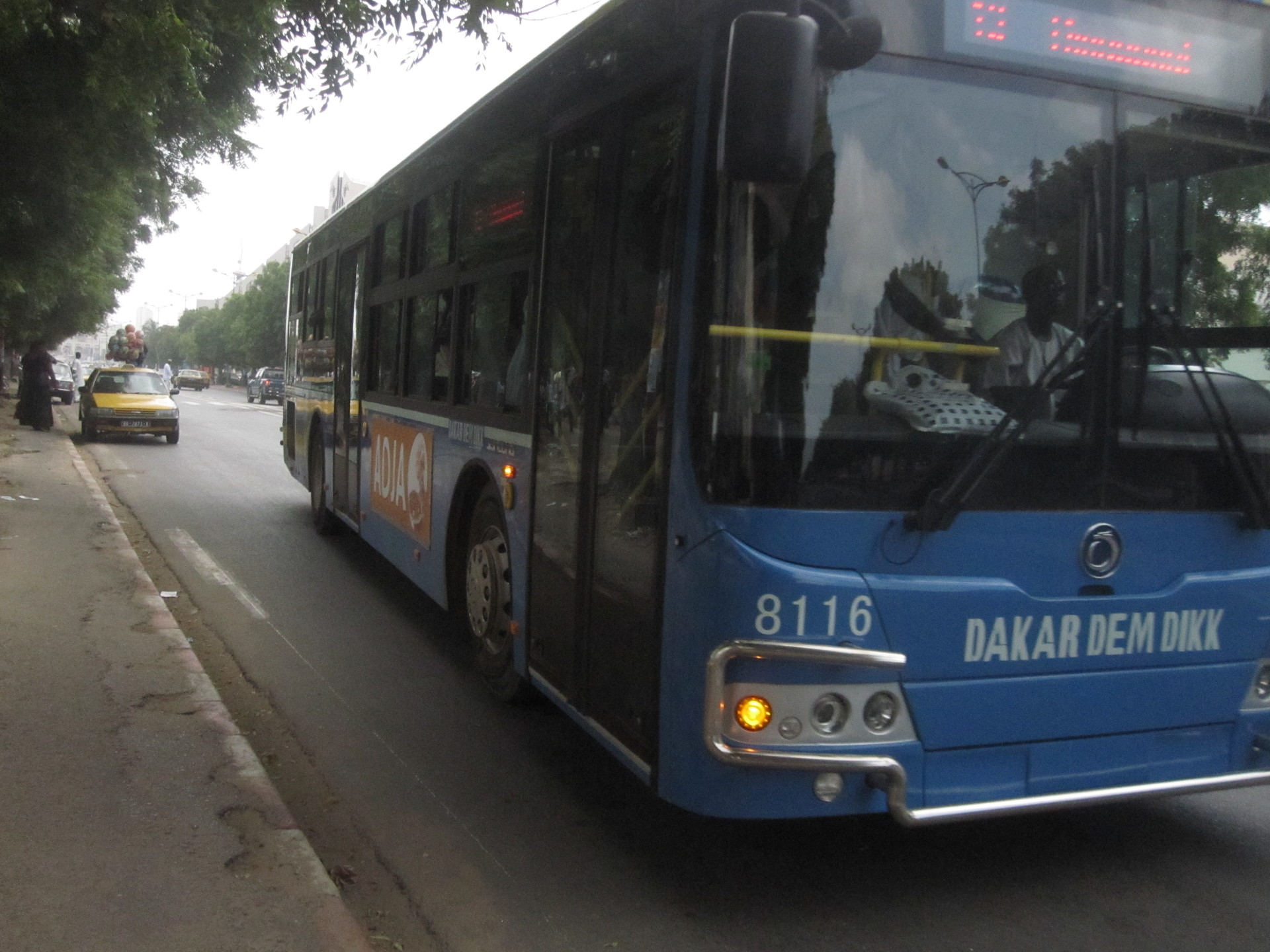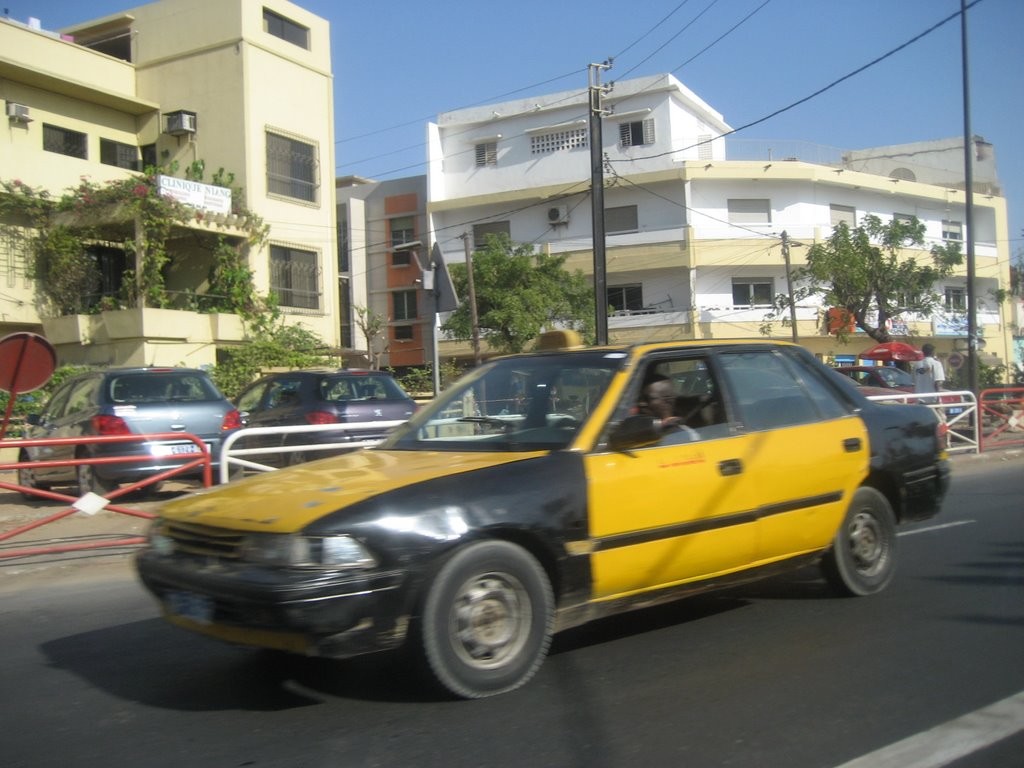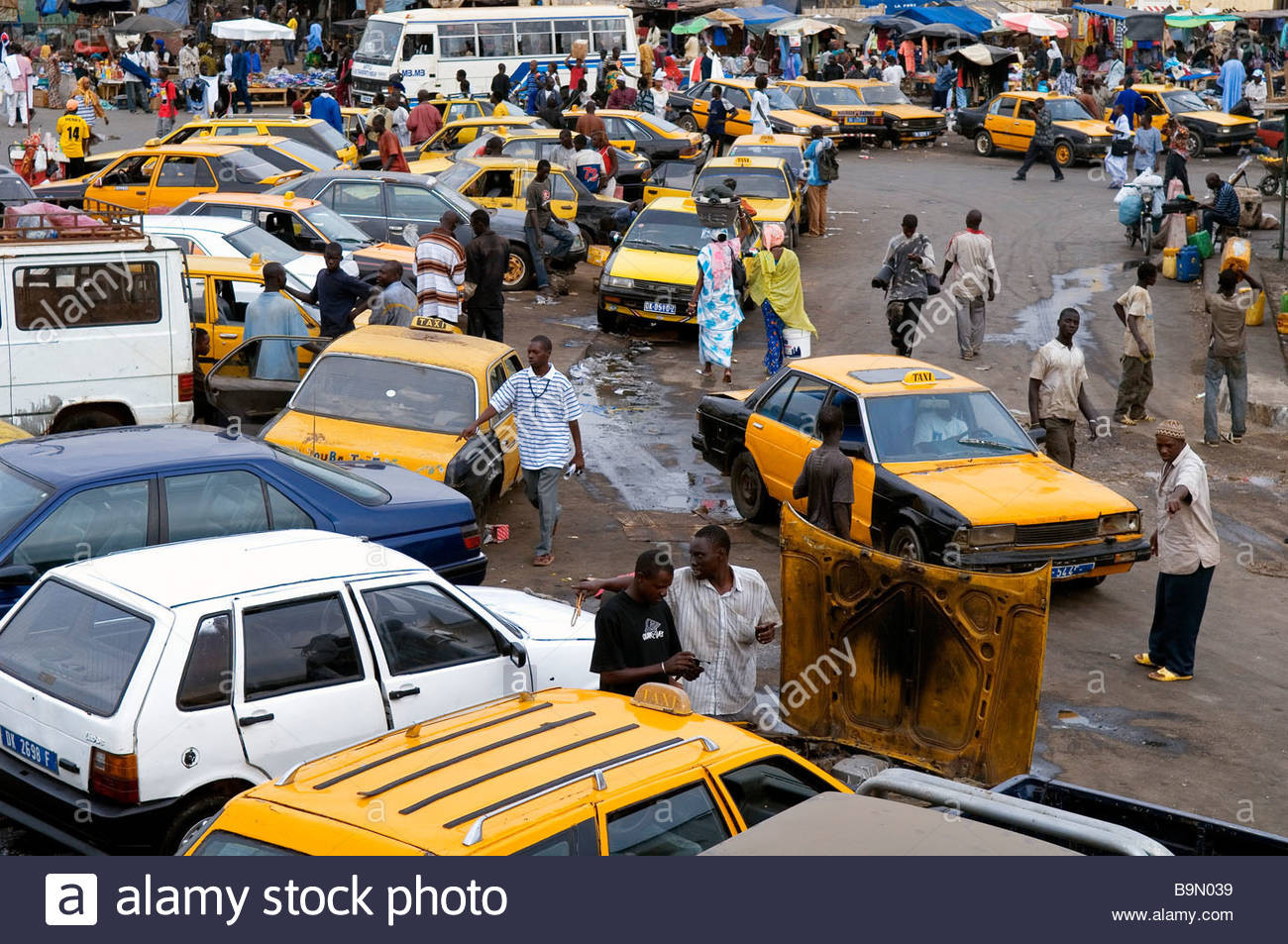Transport in Dakar
Transport in Senegal may seem frightening (crowded, no fixed route, you can get lost), but I have good memories from all the journeys I made. In fact, over the course of three months I had only one bad experience and it was in a taxi, not a bus.
Getting around the city:
The first thing that hits you when you arrive in Senegal is how colourful it is. Everything is full of colour; the road is covered in yellow sand; the buses are painted orange, green and (if they are official buses) blue. The women wear dresses made with traditional local fabric called wax which are full of various patterns and colours. It's actually quite unnerving because some women wear white dresses and... they stay white all day! I wondered how they managed this with all the sand and dirt. It turns out they change clothes two or three times a day and they have several copies of the same dress.

So, for the buses you'll need a bit of time get your bearings truth be told, because they are everywhere, they are not numbered and to put it plainly, it's a mess.
- First there are the big blue buses with a number: these are the public buses. Tickets cost 15 cents while I was there, I suppose it would be a bit more now, twenty or thirty euro cents, which is around 200 CFA francs. You have to commit the itineraries to memory because although they are numbered, I have personally never seen a map of the routes they follow. The number eight was the one which went to the airport at the time. However you should know that if there is no map, there is no timetable either! So for example, you might get two buses arriving ten minutes apart and then nothing for the next hour or two! That's Africa, you learn to be patient! Because of this I would always have a book with me and I read a lot. Almost all buses go through the centre. There are stops marked by a blue panel, sometimes without anything written on them. Sometimes there isn't even a panel... you have to ask people who live in the area. The level of comfort isn't bad, these buses have seats but the problem is that they're generally quite crowded.
- Then there are the multicolour buses (that's what I used to call them, I've forgotten their name in Wolof). These are the same as the one in the photo above. One journey costs 50 or 100 CFA cents (again, it's been a few years since I was there so it may cost a little more now). It depends on the journey you make. You board the bus at the back and there are three iron benches against the interior walls of the vehicle. Lots of people are stood trying to balance upright. Keep an eye on your personal belongings! I got robbed three days before leaving the country on a bus like that because everyone is so tightly packed against each other that we didn't even notice someone putting their hand in our bag. But I should say, that was the only time I had anything stolen, I never had any problems with violence or theft in Dakar despite what they say. It's not dangerous at all in my opinion. (Well alright, I didn't wander around in a miniskirt at night either... let's be clear... ).
How to know where those buses go; the ones which seem to stop everywhere (or to not stop at all, the idea is to never switch off the engine so sometimes they will slow down and it's up to you to jump on board! Idem for getting off! ). You'll see that there are buses which are always stationed in the same place. For example I had one at the end of my road. I know that it went to the Sandaga market. As a result when I wanted to go there I would take that bus. Otherwise the guys who collect the money at the back shout out the destinations. Sometimes you'll hear the one you want. Later I started asking each bus directly: "Sandaga? Sandaga? " and the guys would respond yes or no. If it was a yes I would get on. It's as simple as that. Since the city is divided into districts, you simply say the name of the district. For more precise addresses it's better to take a taxi, which is the third mode of transport.
- Taxis - taxis are everywhere in Dakar, you can't miss them, they are yellow like in New York and black. You can see them in this photo. There is no counter of course, so it's best to find out the price beforehand. For that you can ask people who have lived there or your Senegalese friends. It's very rarely more than 2000 CFA - three euros. In general it's 500 CFA (less at the time), which is 75 cents to travel across two or three districts. I never went to the city centre in a taxi, I always took the bus. What's more, the traffic is dreadful so you can never predict how much time your journey will take. The taxi drivers are always kind, they'll chat with you, which is nice. It's not like at home.


Getting around the country:
To travel around the country you'll need to go to the coach station. The coach station is a large, chaotic car park with hundreds of cars, buses and trucks "stationed", waiting for passengers to fill them up. On arrival people will come up to you straight away and ask you where you're going so that they can try to hassle you into travelling with them. Just tell them your destination and they will take you to a vehicle. If you want lower prices take a bus. Otherwise you can take a taxi-car (they still have a very honest level of cost, as always, I remember travelling across the whole of Senegal and all the way to the border with Gambia for six or seven euros). Here is a photo of the coach station:

Now you see what I mean when I say it's chaotic!
The buses are obviously less comfortable than the cars. However, don't expect anything luxurious about the cars either. Broken roofs, no air conditioning, Senegalese music on full volume for the duration of the journey. One piece of advice: leave your water bottle (preferably frozen if possible) in a black plastic bag at your feet. Incredibly, despite the bag being black, this will keep your water fresh.
If you are travelling a long way you will have to change buses. For this ask a local to explain what to do before you depart. You will then arrive at another coach station and take another bus (you always have to wait for them to fill up before they'll depart) or a taxi-car.

I made a lot of journeys like this just as easily in a bus as in a car. There was only one time I had a little mishap: we were going to Bamboung, a protected nature reserve and a fair and ecological weekend holiday spot. It was along the road towards Gambia so we found ourselves in a car with two large women who were heading to Gambia. We were getting out before that, a good three hours from the border, to go to Bamboung. As we headed into Sine Saloum (the name of the region) we were looking carefully to see where we needed to stop. We started asking the driver to slow down a bit but he gestured that he didn't understand. He was going to take us all the way to Gambia without stopping! We saw a sign saying "Bamboung" and we asked him to stop. He refused, saying that he was only going to Gambia. We were already irritated and that made things worse. We wanted him to stop but he wanted money. Finally he stopped, we got out and refused to give him more than the cost of the journey we had already payed for (that's how it is, you pay in advance) because this was not what we had agreed with our "boss". There was a peacekeeper or some kind of soldier there, in the little forgotten village next to the road where we were. He started reasoning with the driver trying to find out what was going on and in the end we gave the guy three euros so that he'd leave us alone. It was more about the principal than the money itself, and we felt as though we'd been robbed. But, that's the only time we started getting stressed and it didn't last long. On the way back we caught a bus on the side of the road :D
Note that there are also boats and planes for example if you want to go further inland or to Casamance (the part of Senegal which is below Gambia).
Photo gallery
Content available in other languages
- Français: Les transports à Dakar
- Polski: Komunikacja w Dakarze
- Español: El transporte en Dakar
- Italiano: I trasporti a Dakar
- Português: Os transportes em Dacar
Want to have your own Erasmus blog?
If you are experiencing living abroad, you're an avid traveller or want to promote the city where you live... create your own blog and share your adventures!
I want to create my Erasmus blog! →




















Comments (0 comments)